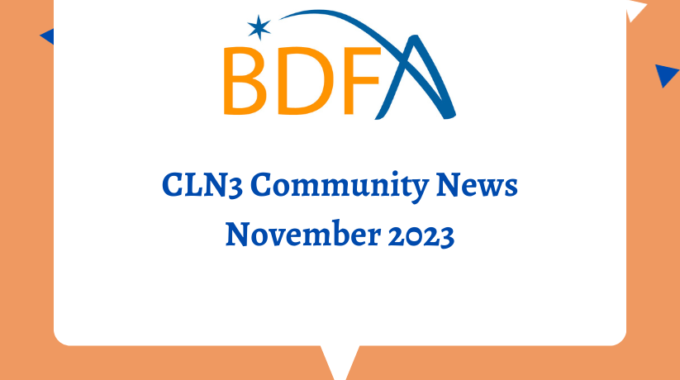Dear CLN3 Community,
Please find below some information about the ongoing research into CLN3, the Miglustat trial hopefully coming next year, and a link to the BDSRA Australia project looking to speech and language in individuals with Batten disease .
If you have any questions please contact Jo (joannanightingale@bdfa-uk.org.uk).
Kind regards,
Dr Joanna Nightingale
Head of Scientific Affairs
CLN3 Report November 2023
This summer, Jessica Centa et al published their ongoing work into using exon skipping as a therapeutic approach for CLN3 batten disease. What does this mean and how could it work?
DNA holds the genetic information for all the proteins synthesized by the cell. It is stored as a series of coding regions called exons, interspersed with non-coding sections called introns which allows for the correct processing of the genetic code into a functional protein. A protein can only function if it can form the correct 3D structure and this is determined by the specific order of amino acids coded in the DNA. The code is read by the protein synthesizing machinery in a series of “3s” (a codon) and the correct series is referred to as a “reading frame.” If the wrong “set of 3” is read then the wrong amino acid, or a “stop codon” can be assembled into the protein, potentially changing the structure and function of the mature protein. Thus, it is really important that the genetic information is read “in frame.”
While the exact function of the CLN3 protein is still unknown, it has been shown to have an important role in lysosome function and is located in the lysosome membrane. The most common mutation seen is a deletion in the coding region of exons 7 and 8 known as CLN3Δex7/8 that results in disruption of the reading frame (a frame shift). This mutation leads to the incorrect processing of the genetic message as now the information is “read” as a premature stop codon in exon 9 thus producing either no protein or a shortened (truncated) protein which is missing the end section and can’t function.
There are many human diseases where an issue with the reading frame causes truncated proteins, but this type of mutation makes it difficult to develop traditional drugs. Researchers are now looking into whether the genetic message can be modulated before it is processed into a protein.
DNA and RNA are types of nucleic acid that can bind to each other. Anti-Sense Oligonucleotides (ASOs) are short chains of nucleic acid designed to bind to other, longer chains of nucleic acid. Currently there are 12 ASO treatments licensed for humans in the UK. They work by pairing to their target and preventing the information from being processed into a protein. Spice-switching antisense oligonucleotides (SSO) are a type of ASO that function in a similar way except they are designed to result in a section of the exon(s) being spliced out (skipped) which then corrects the reading frame for the rest of the instructions. This will produce a protein that will correct for the end of the protein but be missing a section in the middle.
Studies of the CLN3 protein have shown that the end portion of the protein is important for function and this part is missing in patients with the CLN3Δex7/8 mutation. It has also been shown that patients with a different mutation, where the end section is present, have a slower progression. Jessica Centa’s team wanted to know if a protein modified to contain the CLN3Δex7/8 mutation AND the missing end section would have some function. They decided to try “skipping” exon 5 to produce a protein designated CLN3Δex5/7/8 which would contain sections from either end of the normal protein but be missing some sections from the middle.
The initial investigation (2020) was to assess whether exon skipping would induce CLN3Δex5/7/8 expression. They showed that treatment of a CLN3Δex7/8 mouse model with an SSO to correct the reading frame resulted in improved motor coordination, reduced pathology, and increased survival.
To validate their results, reported this year, they produced a mouse model that made the CLN3Δex5/7/8 protein naturally. In comparison to the CLN3Δex7/8 mouse model, the CLN3Δex5/7/8 mice had a less severe disease as determined by behavioural and pathological analysis. This shows that this approach to therapy may have an effect in patients with the CLN3Δex7/8 mutation.
If you wish to read this article, please use this link: https://www.ncbi.nlm.nih.gov/pmc/articles/PMC8008709/
Pharma News
At 4pm CST (10pm GMT) on 15th November 2023, Beyond Batten Disease Foundation held their quarterly Family Research Call. This was led by Mary Beth Kiser (CEO), Dr Ineka Whiteman (Scientific Consultant) and Craig Benson (Chair of the Board of Directors). They gave an overview of the data that led to the Phase I/II clinical trial with Theranexus, of Miglustat before outlining the Phase III with the liquid formulation Batten-1. This trial is due to start in the first half of 2024. The FDA have insisted on a placebo arm which will consist of 50% of the 60-70 participants. Further information about this meeting was sent out on 17th November. We will keep you informed of the latest developments as we hear about them.
Other Patient Advocacy Groups
BDSRA Australia have asked CLN2 and CLN3 parents to be involved in a project looking to speech and language in individuals with Batten disease. If you are interested here is the link:
STUDY-INFO_Flyer_TranslationalCentreForSpeechDisorders_BattenDisease_v2.1.pdf (bdfa-uk.org.uk)

